

GSE Team Leader (Hirakata-Kuzuha Rotary Club)
CEO, Shuei Corporation
We visited the Netherlands (D-1560) from April 21 through May
26, 2001. With Mr. Takumi Hirai playing a central role, our unified GSE team
was able to give well-received presentations. We received rave reviews from
the host Rotary Clubs, of course, and from the participating host families and
others affiliated with the GSE program, and I would like to share with you now
about our experiences.

The earnestness and positive attitude and bearing of each of the team members touched all those who came into contact with them during their vocational study trips, other study trips and sightseeing, and when they had the chance to share their opinions and insights with Netherlanders. All six of us returned to Japan in good health and spirits on May 27 after spending 5 weeks that were both long and yet too short, bringing with us many new friendships and much benefit from fruitful vocational study trips -- more than could ever have fit into our luggage had we been able to put such things in suitcases.
Based upon the information and experiences gained during my time in the Netherlands, I would like to take this opportunity now to report on our trip, giving a comparison (possibly colored by some of my personal dogmatism and prejudices) between Japan and the Netherlands.
1. Historical Background
I don't want to go back too far, so I'll just say that Japan and the Netherlands began to interact with one another around the year 1600. At that time, Japan was just coming out of its "Warring State Period" with the Battle of Sekigahara, and a peaceful and tranquil period of about 200 years was just beginning as Japan entered into its isolationist policy of the Edo Period. On the other hand, the Netherlands had just obtained victory and independence in its 80-year war with Spain at this time. It was just embarking on its golden years as ruler of the high seas during the age of the ocean-going ships.
Our countries took completely different paths, but they had one thing in common -- the city of Dejima in Nagasaki Prefecture. Dejima is the port city where the Dutch were allowed to continue trading with Japan even during the years when Japan cut itself off from the outside world. It wouldn't be going too far to say that Japan was able to respond and relate appropriately to the subsequent opening of its borders based on the information gathered about other nations from the Netherlands during those 200 years of seclusion, thus enabling Japan to avoid the colonization that many other nations experienced from the stronger nations of the West at this time. Also, the influence and benefits Japan received from the Netherlands during those years -- culture and superior scientific knowledge -- were immeasurable.
2. Topography
While Japan is a hilly, volcanic island nation surrounded on all sides by oceans, the Netherlands (which is about the size of the Japanese island of Kyushu) has almost no hills at all. The land of the Netherlands, which faces the North Sea, consists of layers of sediment deposited during the Ice Age, gradually covered by water and by earth and soil that was carried by glaciers and rivers. However, around 700 B.C., erosion by the sea increased dramatically, and sea water began flooding the coastal plains, making bays and lakes salty or brackish.
On the other hand, flooding and overflowing
by the rivers in the lowlands@continued
unabated. From ancient times, the Dutch have worked hard to@increase
the land area of the country by reclaiming land from lakes and the@sea
to help provide for a population that was growing along with its@industry
and economy. As a result of these efforts, 30% of the nation's land@is
below sea level, and more than 20% of it has been reclaimed since the@13th
century. In 1932, a 32-km long dike was constructed which reclaimed a@large
portion of land from the sea and formed Lake Ijsselmeer, and since@then
much of the lake has been drained and reclaimed. Also, about 8% of the@Netherlands
is rivers, waterways and canals. The canals and waterways@traversing
the country have a combined length of some 5,000 km, and the@Dutch
are even now applying the things they have learned from the endless@flooding
that has taken place in the Netherlands to help them in their water@management.

3. Population and Population Density
The population of the Netherlands
is only 16 million, compared to Japan's@120
million, but because of the small size of the country, the population@density
is higher in the Netherlands, with a density of 466 people per@square
km compared to Japan's 338 per square km. However, compared to Japan,@which
has a narrow belt of flat land along the coast and high mountains@comprising
the rest of the land, the peaceful countryside scenes so common@in
the Netherlands give the illusion that the population density is less@than
that of Japan.

4. Japan's Imperial Family and the Netherlands' Royal Family
Japan's imperial family and the Netherlands' royal family are completely different as far as their historical backgrounds are concerned, but both of them are symbols of their respective countries, are respected and are the center of much interest by the general populace. In this regard, both families are quite similar. The Dutch are very interested in their royal family, and because of the general openness of the royal family, they are, it seems, more loved by their citizens than the Japanese imperial family. The current royal family, Orange-Nassau, is descended from Willem I the Silent, the man who fought with his countrymen against the Spanish in their war for independence in the 16th century.
The royal palace is located in the last place we visited during
our time in the Netherlands -- the suburbs of Apeldoorn. The gardens are well
cared for, and except for the times when the royal family is using them, the
rooms of the palace are open to the public. The money collected as entrance
fees covers about half of the annual operating expenses. Two days before we
returned to Japan, we were invited to attend a concert that was held in one
of the palace rooms, and I will always remember that time fondly.
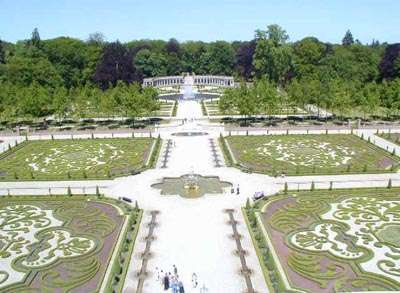
5. The Economic Situation
After World War II, Japan experienced amazing economic growth, but we have been going through a very difficult struggle since the economic bubble burst ten years ago. During those same ten years, the economy of the Netherlands has grown from 2% to 4% annually with inflation of about 2%. Because of this, the unemployment rate, which was about 8% in 1994, has dropped to its current level of less than 2%. It is hard to say what will happen in the future, but there is no doubt that the economy has reached its peak. Breaking down industry based upon percent of GDP, we see that Primary@Industries (agriculture/livestock/fishing) makes up 3%, Secondary Industries (construction industry/manufacturing) accounts for 39% and the rest, 58%, is the result of Tertiary Industries (commerce, finance and insurance, transportation and communication, real estate, other services).
Agriculture and livestock farming make up only 3% of the GDP, but the exports of produce and processed food products account for 23% of the Netherlands' export income. Agriculture is a vital export industry, with the Netherlands being the third largest agricultural exporter in the world, behind the United States and France. Livestock-related products account for one third of these exports, flowers and bulbs 10%, and the remaining money comes from shipping, currency trading, and insurance, which have been mainstays in the Dutch economy since its golden years as the world's leading seafaring nation.
6. Free Trade
As seen from the figures in the previous section on the economy, both the Netherlands and Japan need to expand their Secondary and Tertiary industries if they are to maintain their current level of prosperity. Such prosperity will only result if we contribute to world peace and support free trade. In Japan, Secondary industry is the main pillar of our economy, whereas Tertiary industry is the mainstay of the Netherlands' economy. On the basis of income, 80% of the Netherlands' exports go to the EU, 4% to the United States and just 1% to Japan.
Japan, with its trade surplus and huge economy, is a global leader in giving economic assistance to nations in need. The Netherlands ranks third in the world based on giving in terms of %GNP, giving 0.8%, and on the basis of amount given, it ranks 6th. Most of its economic assistance is in the form of grants. Also, it is actively involved in NGOs, and about 10% of its Overseas Development Assistance aid is distributed through NGOs.
7. Shipping Industry
Japan's shipping industry is almost exclusively related to its own exports and imports, and the domestic transportation of those products. The Netherlands' hub ports and hub airports, on the other hand, serve as a starting points for the export and shipping of other nations' products.
Schiphol Airport, which has four runways, is a large airport, serving as one of the major hub airports of Europe, along with London's Heathrow, Paris' Charles de Gaulle, and Germany's Frankfurt airports. Even so, Schiphol Airport is now too small, and the government is studying the feasibility of building a new airport about 40 to 50 km north-northeast of Amsterdam on a man-made island. Compared to Japan, the Dutch have much more foresight than the Japanese government does in regard to planning for new airports.
What Schiphol Airport is to air transport, Rotterdam port is to freight shipping. Rotterdam is the world's leading port, and the vast amount of products landing in Rotterdam are bound not only for the Netherlands, but are also shipped out to every part of Europe by land, sea and air. In addition, products from all over Europe arrive in Rotterdam to be loaded on ships that will carry them to markets all over the world. Dutch merchants avail themselves of roads, railways, and the waterways, including the Rhine River, to move freight and merchandise to the leading metropolises of Europe, accounting for about 40% of the EU's international freight shipping.
8. Agriculture, Livestock Farming and Fishing
A few hundred years ago, both the people of Japan and the the people of the Netherlands made their living farming and hunting, for the most part. Both nations were actively involved in fishing, Japan in the seas surrounding the Japanese islands and the Netherlands in the North Sea and Lake Ijsselmeer. Today, Japan is dependent on imports for the majority of its food, while the Netherlands is self-sufficient through its agriculture, livestock farming and fishing industries. It is an exporter of processed livestock-related products. Also, the Dutch export flowers and tulip bulbs.
Foot & Mouth Disease and Mad Cow Disease, both of which
recently reached epidemic proportions in England, have been discovered in four
locations in the Netherlands (as of April, 2001). The exact cause of the outbreaks
is unclear, and there is no system of prevention established at present. For
this reason, even though this is not a large-scale outbreak, everyone in the
Netherlands is quite concerned about what may happen. Because of this fear,
even though the time we were in the Netherlands was the best time of year for
livestock to be left outside to graze, there were only a few farmers who had
let their livestock outside their barns out of fear that their animals might
catch the disease from the air. Also, celebrations during Queen's Day (April
30) were rather subdued this year because of this worry.

9. Compulsory Education and Religion
We visited a brand new public elementary school while we were in the Netherlands. In the same area, there were a number of schools established that were religious schools. There was a Catholic school, a Protestant school and a third religious school, and each one of them had a roof of a different color (blue, red and yellow). We visited all of these schools, and there was a noticeable difference in the students' attitudes and desire to learn. I don't really know for sure, but it may have had something to do with the style of education their parents had received or their family's financial status.
Dutch children go to elementary school from age 4 through 12, with children starting to go to school from 1 to 2 years earlier than other developed nations. The reason for this is that almost all the children start going to kindergarten or nursery school when they are 4 years old, and those who do so are considered to be part of the public education system. This seems reasonable to me. Just what, exactly, do the children study at age 4? It has nothing to do with helping them increase their knowledge; rather, both kindergartens and nursery schools spend most of the time helping the children learn to relate to others in a group through playing games.
It seems that no matter what country you live in, there are common problems related to the education of children. There are always problems with students dropping out of school and problems with teachers, but the ways in which countries deal with these problems are quite different. In the Netherlands, the children's education problems are classified by three main causes: physical handicaps, poor home environment, and immigration.
The region we visited has 70 communities in it, and there are 200 elementary schools there. Of these 200 schools, 185 are normal schools and 15 are special schools. The Netherlands is a group society, and, as such, it makes use of these special schools to respond to the needs of special students. I got the impression that they give considerable consideration to the details and individual situations of each child when determining how to best help them.
As for teachers, there are teacher training schools (in Japan we would call them Teachers Colleges) that educate teachers who will teach at schools throughout the region. These teacher training schools are characterized by students aged 18 to 22 or 23; and teachers who are currently working at regional schools also attend the training schools regularly, or at their own discretion, for refresher courses. These schools also teach foreign languages to help teachers deal with immigrant children.
10. Struggle against Natural Disasters and Wars
While Japan is often assailed by natural disasters such as earthquakes and typhoons, the Netherlands has to deal with the damage caused by floods and inundation by sea water, because of its reclaimed land and the fact that much of the nation lies below sea level. For this reason, underground water levels are monitored nationwide and safe levels are maintained and controlled mechanically.
In Japan, it is only natural that such maintenance and control
would be handled entirely by government organizations, but in the Netherlands,
this responsibility is borne by boring companies that are affiliated with small
and medium-size private companies.
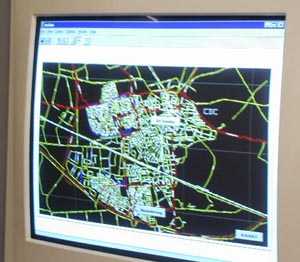
11. The Fullness of Life
It is, of course, difficult to measure or evaluate the fullness of life, since everyone has their own personal value system, but I will do my best.
1) Individuality in one's own home
The average Netherlander's plan for his/her life includes owning a home. This is followed by having a yard and garden filled with trees and flowers, and next on the list is having a pet. Of course, before these last two things comes providing electric appliances for the home and a car, just as in Japan.
The most surprising thing to me was the individuality displayed in homes, regardless of whether those homes are in the city or in the country. I did not see any houses that looked exactly alike. There are always trees and bushes planted in the front and back yards, and a flower bed. They were so beautiful that I felt I just had to take pictures of many of the homes I saw. Even around condominiums, there is ample space allocated for trees and flower beds. I asked about the price of land, and it is not cheap, since the nation is so small. Because each house is so different, it seems that they are kept for a very long time, and except for a few new homes, most of the homes sold are older homes, which many new owners renovate on the inside.
The pets in the Netherlands (mostly dogs) are very well trained.
I didn't see even one stray dog during my five weeks there. Also, although they
are not as common as special paths provided for cyclists, I was surprised to
see that there is a path marked by a dog signs , meaning that this path is allocated
for dog walking only.
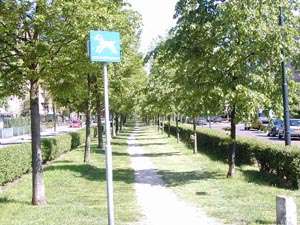
2) Forests for relaxation
In the mornings and evenings, one can see many people taking
their pets for a walk in the forests surrounding the cities. On these paths,
many of the dogs are let off their leashes, but it seems that there is almost
no danger of fights between dogs. I heard that such forests are very well maintained.
In Japan, one would naturally expect that any maintenance work on public land
would be paid for by the city, but in the Netherlands, such work is handled
by volunteers and paid for by contributions from the citizens. For this reason,
there is a high sense of public morals and beautiful forests exist everywhere.
This is something I would very much like to see Japan learn from.
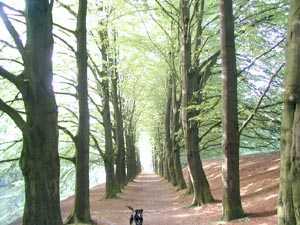
3) Simple meals
With the economic growth that followed the end of WW II in Japan, eating habits became much more affluent. People who grew up in lean times began craving high-class food. Today, even if a person chooses something to eat himself and pays for it, it is very common for him to just leave it on the plate if it doesn't taste good enough. Things in the Netherlands, where people have learned discipline throughout their history, however, are completely different. Food is viewed as a necessity for life, and taste and luxury always come second. In particular, I felt that it is absolutely unacceptable to leave something on your plate that you have chosen. Also, I saw people take a moment to say a silent prayer of thanks for their food before and after each meal, both in my host homes and at Rotary Club meals.
As I considered the situation in Japan today, I felt very keenly the need for us to think maturely about how difficult it was to find food after the war and to reconsider the fact that we are now dependent upon imports from other countries for more than half our food.
4) Home parties
In the countryside in Japan, people still get together from time to time with their neighbors, but it is rarely seen in the cities.
In the Netherlands, though, most houses are designed in such
a way as to provide a space for "home parties." The first floor usually consists
of a kitchen with a dining area and a living room, and the bedrooms are on the
second floor. There is always enough space on the first floor for "home parties"
of more than 20 or 30 guests, and during our time in the Netherlands this spring,
we attended many such parties. Summer time (daylight savings time) begins in
April, so it is light outside until 9:00 at night if the weather is fine. Many
people prefer to enjoy a barbecue outside on the patio or grass to having a
party inside. People drink a lot, eat a lot, and talk a lot at these parties,
and they serve as places where people can foster neighborhood social life and
friendship.
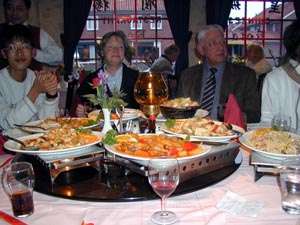
12. Public Facilities
The abundance of public facilities plays an important role in providing a fulfilling life to Netherlanders.
1) Museums and art museums
Even in Japan, it is becoming more common for towns to build
museums for their citizens, and in most towns and villages in the Netherlands,
one can find museums and art museums. I was surprised to learn that even though
there are just 16 million people in the Netherlands, there are about 1,000 museums.
During our trip this spring, we visited no less than 10 museums and art museums
in the places we visited officially as the GSE team. Among the places we visited
were old, renovated castles (such as the Huis Bergh and the royal palace), the
New Land Museum (which features land reclamation efforts over the centuries
and the history of the golden age of merchant vessels), the Batavia-yard Warship
Museum, the Tile Museum (which features interior decorating materials), a wine
museum with several million bottles of wine (which has displays featuring the
history of wine making throughout Europe, the production process and the implements
and items used in making wine), a sculpture museum (which has many pieces of
art scattered throughout a wooded area that meld with the surrounding natural
beauty), and an Open Air Museum (which features the farm houses of 17th century
Holland, a variety of windmills for differing purposes, and an old Dutch street
lined with buildings resembling those of the times). In addition, I visited
no less than 20 other museums when I went on sightseeing trips to Amsterdam,
Rotterdam, Leiden and other cities with my host families. None of these museums
seemed out of place or like they were put there just to have a museum there.
They all had a large number of displays and items, and the entrance fees were
very reasonable.

2) Libraries
Both Japan and the Netherlands have libraries in almost every city and town, and both have traveling libraries as well. Our countries are also similar in that computers, TVs, videos and other new technologies are fostering young people who do not read books. In the Netherlands, libraries also lend tapes, CDs, videos and other things, and they offer a wide variety of these highly popular items.
3) Concert halls
In the Netherlands, they have facilities and programs in towns
of just 20,000 or 30,000 people that are unheard of in Japan. There are music
lessons for elderly men and women in both group and private lesson formats,
and facilities to meet the needs of each type of music class. The sound quality
in these facilities is quite high. At an orchestral music practice session for
elementary, junior and senior high school students, it was heartwarming for
us to see a couple of adults and even retired the active duty earnestly playing
the cello under the direction of the music teacher.
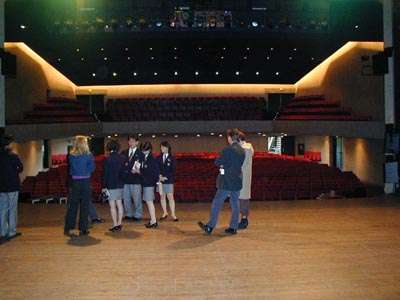
4) Sports facilities
There are almost no sports facilities set aside specifically for baseball,
sumo and the martial arts, as we ccer is the national sport of the Netherlands,
and I was surprised to learn that a small nation like that has 70 to 80 professional
soccer teams. Each of them is ranked, and they all play very hard every year
in order to raise their ranking. Of course, since every area has its own soccer
team, the local residents flock to the local soccer stadiums to support their
teams. Every city, town and village has its own grass soccer pitch, naturally,
and you can always see the billboards of local companies (who sponsor the teams)
displayed there.
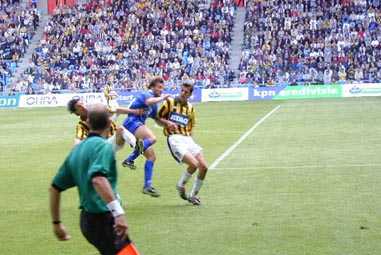
Winter sports in a flatland nation like the Netherlands consists of ice skating, and the Dutch are very active in the Winter Olympics and World Cup skating. Many world-class skaters are from the Netherlands.
Bicycle racing is also a specialty of the Netherlands, a land where cycling is very popular. On their days off, many Dutch don protective headgear and become absorbed in practicing their cycling. This includes children, and one can feel the depth of interest and involvement that exists in the Netherlands. Recently, it is sometimes possible to see someone enjoying cycling in this way even in Japan, as people begin looking for new ways to spend their free time.
13. The Welfare System
1) Hospitals
One thing that is decisively different between hospitals in our countries is the fact that in the Netherlands, religious care in hospitals is considered a given. Also, the Dutch have enacted legislation that allows the elderly to choose euthanasia to avoid suffering. The euthanasia problem is now tied up with religion, and debate is taking place on a variety of points.
2) Welfare facilities
In Japan, we are quite busy developing and expanding facilities, and coming up with laws and systems that will meet the needs of our rapidly aging society. In the Netherlands, however, they have been grappling with this issue and hospital care for the elderly for a long time. I talked to my host families about how their parents were being cared for, but there wasn't any sense of concern or worry like we find here in Japan regarding problems dealing with the elderly.
As I mentioned in the section on mandatory education, the Netherlands
has done much to deal with the needs of handicapped youth. An example of one
thing they are doing is offering music therapy, and it is proving helpful in
relieving some of the emotional and mental stress these young people are experiencing.
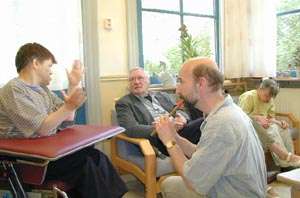
3) Grave sites
I had thought that cemetery plots and graves were something that one generation passed down to succeeding generations, but in the Netherlands new government guidelines have been established that make cemeteries national property. Things vary slightly from place to place, but a typical plot of 10 sq. meters costs about 3,000 gilders (approx. \150,000 or US$1,250), and husbands and wives can be buried side by side. After 25 to 30 years, the burial plot automatically becomes government property. One reason for this is to help make the most efficient use of land in this small country, but the policy is also aimed at helping to make sure that the plots are always maintained in case the descendants one day stop taking care of the grave sites.
14. Miscellaneous
1) The Dutch are the world's number one coffee lovers
Before anything starts in the Netherlands, without fail, coffee is served. Without it, nothing can proceed smoothly. During our 5 weeks there, we visited more than 100 companies, public organizations, homes, etc., and we were served coffee at each and every place. Those like myself, who do not drink coffee, have to always say something like, "May I please have tea?" or "May I please have some water instead?" or "No, thank you."
Sometimes, we were served a cookie or cake with our coffee.
This may just be my own opinion, but it seemed to me that when we drank coffee
while talking, it helped make the atmosphere more conducive to mutual communication
and allowed the subject at hand to proceed smoothly. Maybe the use of coffee
as a kind of buffer solution is one example of human wisdom.

2) Legalization of drugs
The Netherlands is a rare country in that it has legalized the use of "soft drugs." If you want to drink coffee there, you don't go to a "coffee shop." In the Netherlands, a "coffee shop" is a place were people go to smoke soft drugs like hashish and marijuana legally. If you want to drink coffee, you have to go to a cafe.
In Arnhem, the fifth region we visited, we made a study trip
to the office of the chief of police. He showed us a number of samples of drugs,
and gave us a detailed explanation of how the drugs came into the country, how
they are used, and the symptoms that accompany the use of each drug. We then
got a ride in a patrol car and went to visit a "coffee shop" with him. Even
though it was still morning, there were some patrons there. Most of them were
relatively young, say about 30 years old. The place was filled with smoke and
had a unique smell to it. Being there for just that short time gave me the feeling
that I was actually using the drugs we had been told about earlier at the police
station.
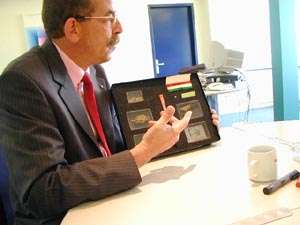
When asked why these drugs were made legal, we were told that the greater the degree of illegality, the more such drug traffic would move underground, and along with higher prices would come more violent crime. He also stated that the harm from soft drugs was less than that of tobacco cigarettes. It seems that soft drugs were legalized for those two reasons.
The daily sales at "coffee shops" come to about 500 mg, with each customer smoking about 5 mg. To be honest, it appeared to me that managing the illegal use of soft drugs would be rather difficult.
3) Horseback riding
In Japan, horseback riding is considered a high-class sport or pastime, and there are very few people who do it. In the Netherlands, however, many people raise livestock and, as a result, many people have horses and there are riding clubs all over. I heard that almost all the Dutch know how to ride a horse. To them, it is not simply a sport or a leisure activity. Horses are sometimes very important when it comes to fleeing the dangers of flood waters, etc. in this lowland nation.
4) Markets
On a given day and at a given time, one can find markets open
for business along the street, in the open space around city hall and in the
middle of wide roads. Much of what one sees on sale at the markets is fresh
produce, but one can also find electrical appliances and other household items
for sale at reasonable prices. It seems that there are quite a few households
that go to such markets to buy all the fresh produce they will need for a whole
week on one day. Shops set up temporary tents for business, merchandise that
has been brought in by car is on display in grand style, and the markets do
a good job attracting customers and getting them to buy things. Depending on
the stand, however, prices will vary for similar items, so those who are not
regular customers need to be careful not to stop at the first place they see
and buy something. The secret is to walk around and check the prices, etc. at
the various stands before deciding on your purchases.
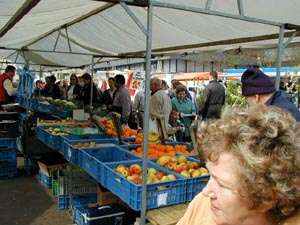
5) Double-flowered cherry trees
When it comes to beautiful cherry trees, I had thought that
Japan had a "patent" on them, but there are very many cherry trees in the Netherlands,
which amazed me very much. There are some cherry trees with thick trunks that
look like they are several hundred years old. But, almost all of the trees have
double-flowered blossoms. I didn't see any cherry trees like our Yoshino cherry
trees or mountain cherry trees. I wonder if they were sent to the Netherlands
from Japan just like those along the Potomac River in Washington, D.C. were
... or has the Netherlands been their natural habitat for many, many centuries?
I don't know, but one thing is for sure. Their cherry trees are certainly no
less beautiful (and may be even more beautiful) than those we have in Japan.
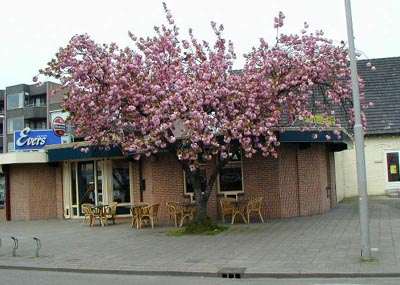
Conclusion
Lastly, I would like to take this opportunity to express my deep thanks to the host clubs and host families of D-1560, and to all those we met during our time in the Netherlands.